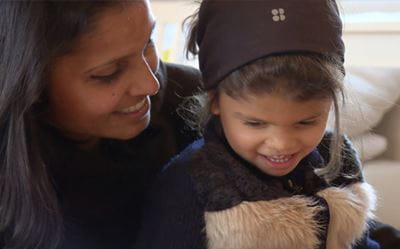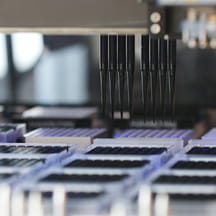Looking back, Taruna Reddy says the time following her baby’s birth feels like “a bit of a blur.”

At just a few weeks old, little Alya began having seizures. They intensified rapidly, and at five weeks old, she experienced status epilepticus—a medical emergency in which a patient has seizures lasting more than five minutes without returning to a normal level of consciousness between episodes. Reddy rushed her daughter to the hospital, where emergency room doctors stabilized Alya and began searching for causes of the mysterious seizures.
“We had no idea what was going on—we didn’t even know if she was going to live,” Reddy says. “It was a very scary and challenging time.”
Neurological tests revealed no tumors or other apparent source of the seizures. And while Alya was able to return home on multiple medications—including a maximum dosage of valium—her seizures continued. Worse, they were most frequent at night, so the young girl’s sleep quality was severely compromised.
Diagnosis prompts ketogenic diet for seizures
It wasn’t until around Alya’s third birthday that she was diagnosed with PACS1 syndrome, an extremely rare genetic condition affecting a child’s speech and language, intellectual capacity and facial appearance. The disease also frequently causes additional neurological, behavioral and health problems. With no cure for PACS1 syndrome and—despite the heavy medication load—no relief for Alya’s seizures, Reddy turned to the Epilepsy Center at Boston Children’s Hospital for help.
Among the first changes they prescribed to Alya’s treatment plan was a ketogenic diet.
“Our goal was not to contribute to any kind of cognitive burden; some of the anti-seizure medications can also make cognitive problems or developmental delays worse,” says Tobias Loddenkemper, M.D., director of clinical epilepsy research at Boston Children’s, and professor of neurology at Harvard Medical School. “The ketogenic diet is different in that it is not a medication with side effects and can actually make some patients sharper—and, by the same token, prevent recurrence of status epilepticus.”
How a ketogenic diet works for epilepsy
The diet, which consists of high-fat foods and very few carbohydrates, has been used to treat epileptic seizures for decades. More recently, studies have demonstrated the ketogenic diet’s benefits for pediatric patients: more than half the children who go on the diet experience at least a 50% reduction in their seizure activity, while about 10-15%—including Alya—become seizure-free. It’s effective because the diet reduces the amount of glutamate (an excitatory neurotransmitter) in the brain while enhancing the synthesis of GABA (gamma-aminobutyric acid, an inhibitory neurotransmitter), making it less likely for a seizure to occur.
Still, it’s not widely used to treat epileptic symptoms in pediatric patients. For most diagnoses, the ketogenic diet is only considered for patients whose seizures are not controlled with medications. And, according to Loddenkemper, the diet can create dangerously low sugar levels in some patients. So he teams up with Anna Pinto, M.D., Ph.D., assistant professor in the department of neurology; co-director of the Sturge-Weber Syndrome Clinic; and director of the Ketogenic Diet Program at Boston Children's, to conduct testing to ensure patients can safely tolerate the diet before proceeding.
A team effort
Successfully implementing a ketogenic diet plan requires a multi-disciplinary approach, Loddenkemper says. That’s been central to Alya’s progress and should be a focal point for any health care provider considering the diet for their patients.
“It’s really been a combination of the social workers, nursing support and the physicians working together along with Dr. Pinto’s ketogenic diet team—dieticians in particular— managing the diet plan jointly with Alya's mom, who is very diligent in implementing it,” Loddenkemper says. “It takes a village.”
That support team has made dramatic improvements in the lives of Alya and her family. Although some aspects of her PACS1 syndrome are irreversible, including her limitations on speech and cognitive development, she’s otherwise a physically capable nine-year-old girl who enjoys attending school, playing games and skiing.
“At least having that neurological piece of her disorder under control is life changing—she’s just a really happy kid now without the seizures,” Reddy says. “We've come a long way from when she was five weeks old and we were in the emergency room.”



